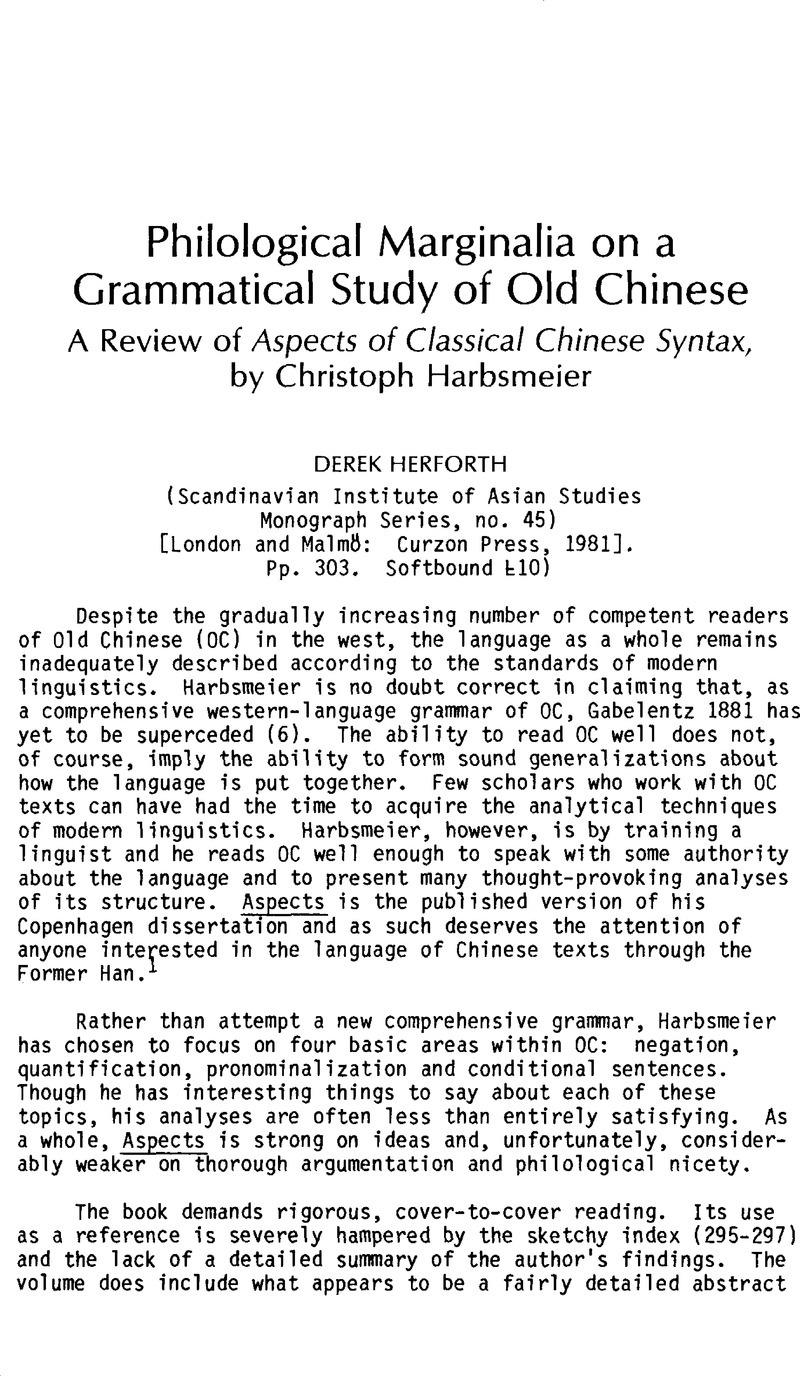No CrossRef data available.
Article contents
Philological Marginalia on a Grammatical Study of Old Chinese: A Review of Aspects of Classical Chinese Syntax, by Christoph Harbsmeier
Published online by Cambridge University Press: 26 March 2015
Abstract
An abstract is not available for this content so a preview has been provided. Please use the Get access link above for information on how to access this content.

- Type
- Review Articles and Book Reviews
- Information
- Copyright
- Copyright © Society for the Study of Early China 1985
References
BIBLIOGRAPHY
Chafe, Wallace L. 1976. “Giveness, contrastiveness, definiteness, topics and points of view.” In Subject and Topic, edited by Li, Charles N., pp. 27–55. New York: Academic Press.Google Scholar
Ren, Chao Yuen. 1968. A Grammar of Spoken Chinese. Berkeley: University of California Press.Google Scholar
Mengjia, Chen . 1956. Buci zongshu
. 1956. Buci zongshu  (A comprehensive discussion of oracle-bone inscriptions). Beijing: Kexue chubanshe
(A comprehensive discussion of oracle-bone inscriptions). Beijing: Kexue chubanshe  .Google Scholar
.Google Scholar
Dain, Alphonse. 1964. Les manuscrits (nouvel le édition revue). Paris: Société d'édition ‘Les Belles Lettres’.Google Scholar
Demiéville, Paul. 1950. “Archaismes de prononciation en chinois vulgaire.” T'oung Pao 40:1–59.CrossRefGoogle Scholar
Dobson, W. A. C. H. 1959. Late Archaic Chinese. Toronto: The University Press.CrossRefGoogle Scholar
Graham, A. C. 1984a. “Review of Aspects of Classical Chinese Syntax, by Christoph Harbsmeier.” Acta Orientalia 45:196–204.Google Scholar
Graham, A. C.. 1984b. “Review of Chinese Classics: Tao te ching, translated by D. C. Lau.” Bulletin of the School of Oriental and African Studies 47:387–389.CrossRefGoogle Scholar
yanjiushi, Guojia wenwuju guwenxian ed. 1980. Mawanqdui Han mu baishu (yi)
ed. 1980. Mawanqdui Han mu baishu (yi)  (—) (Silk manuscripts from the Han tombs at Mawangdui [One]). Beijing: Wenwu chubanshe
(—) (Silk manuscripts from the Han tombs at Mawangdui [One]). Beijing: Wenwu chubanshe  .Google Scholar
.Google Scholar
Xiliang, Guo et al., eds. 1981. Gudai Hanyu
et al., eds. 1981. Gudai Hanyu 
 (Ancient Chinese language), vol. 1. Beijing: Beijing chubanshe
(Ancient Chinese language), vol. 1. Beijing: Beijing chubanshe  .Google Scholar
.Google Scholar
Haiman, John. 1985. Natural Syntax: Iconicity and Erosiono. Cambridge: Cambridge University Press.CrossRefGoogle Scholar
Zhengrong, Han 1984. Gu Hanyu xuci shouce
1984. Gu Hanyu xuci shouce  (Handbook of ancient Chinese particles). Changchun: Jilin renmin chubanshe
(Handbook of ancient Chinese particles). Changchun: Jilin renmin chubanshe  .Google Scholar
.Google Scholar
Fanggui, Li . 1980. Shariggu yin yanjiu
. 1980. Shariggu yin yanjiu  (Studies in Old Chinese phonology). Beijing: Shangwu yinshuguan
(Studies in Old Chinese phonology). Beijing: Shangwu yinshuguan  .Google Scholar
.Google Scholar
Zhong, Ma . 1983. Gudai Hanyu yufa
. 1983. Gudai Hanyu yufa  (Ancient Chinese grammar). Jinan: Shandong jiaoyu chubanshe
(Ancient Chinese grammar). Jinan: Shandong jiaoyu chubanshe  .Google Scholar
.Google Scholar
Fumio, Otake, Takeo, Otake trans. 1962. Shiki-Honki, shohyō, seka hen: Sekai bungaku taikei
trans. 1962. Shiki-Honki, shohyō, seka hen: Sekai bungaku taikei  (The Shiji - Basic annals, tables, and hereditary houses: Compendium of world literature), 5A. Tokyo: Chikuma shobō
(The Shiji - Basic annals, tables, and hereditary houses: Compendium of world literature), 5A. Tokyo: Chikuma shobō  .Google Scholar
.Google Scholar
Pulleyblank, E. G. 1959. “Fei  wei
wei and certain related words.” In Studia Serica Bernhard Karlgren Dedicata, edited by Egerod, S. and Glahn, E., pp. 178–189. Copenhagen: Einar Munksgaard.Google Scholar
and certain related words.” In Studia Serica Bernhard Karlgren Dedicata, edited by Egerod, S. and Glahn, E., pp. 178–189. Copenhagen: Einar Munksgaard.Google Scholar
Pulleyblank, E. G., 1973. “Some new hypotheses concerning word families in Chinese.” Journal of Chinese Linguistics 1:111–125.Google Scholar
chubanshe, Shanghai guji ed. 1984. Ershisi shi jizhuan xuanyi congshu, Shiji jizhuan xuanyi
ed. 1984. Ershisi shi jizhuan xuanyi congshu, Shiji jizhuan xuanyi 
 (Compendium of selected translations from biographies in the twenty-four histories: selected translations from the Shiji), vol, 1. ShanghaiGoogle Scholar
(Compendium of selected translations from biographies in the twenty-four histories: selected translations from the Shiji), vol, 1. ShanghaiGoogle Scholar
Stimson, Hugh M. 1971. “Sheir shwu
shwu ‘who, whom’ and moh
‘who, whom’ and moh ‘none’ in Old Chinese.” Journal of the American Oriental Society 91:447–466.CrossRefGoogle Scholar
‘none’ in Old Chinese.” Journal of the American Oriental Society 91:447–466.CrossRefGoogle Scholar
Stimson, Hugh M.. 1972. “More on Peking Archaisms.” T'oung Pao 63.1-5:172–189.CrossRefGoogle Scholar
Ken'ichl, Takashima. 1973. “Negatives in the King Wu-ting Bone Inscriptions.” Ph. D. dissertation. Seattle: University of Washington.Google Scholar
Traugott, Elizabeth Closs. 1985. “Conditional Markers.” In Iconicity in Syntax, edited by Haiman, John, pp. 289–307. Amsterdam: John Benjamins Publishing.CrossRefGoogle Scholar
Fengfu, Tsao. 1982. “The Double Nominative Construction in Mandarin Chinese.” Tsing Hua Journal of Chinese Studies, n.s. 14.1-2:275–297.Google Scholar
Waley, A., trans. 1937. The Book of Songs (Evergreen edition). 1960 Reprint. New York: Grove Press.Google Scholar
Li, Wang . 1928. Tong yuan zidian
. 1928. Tong yuan zidian  (Etymological dictionary). Beijing: Shangwu yinshuguan
(Etymological dictionary). Beijing: Shangwu yinshuguan  .Google Scholar
.Google Scholar
Kenkō, Yoshida , trans. 1982. Shiki
, trans. 1982. Shiki (The Shiji), pt. 7 (Seka
(The Shiji), pt. 7 (Seka [Hereditary houses], vol. 3): Shinshaku kanbun taikei
[Hereditary houses], vol. 3): Shinshaku kanbun taikei  (Compendium of Chinese literature newly translated), vol. 87. Tokyo: Meijl shoin
(Compendium of Chinese literature newly translated), vol. 87. Tokyo: Meijl shoin  .Google Scholar
.Google Scholar
Fagao, Zhou . 1961. Zhongguo gudai yufa, zaoju
. 1961. Zhongguo gudai yufa, zaoju
 (Ancient Chinese grammar, sentence structure), vol. 1. Zhongyang yanjiuyuan lishi yuyan yanjiuso zhuankan
(Ancient Chinese grammar, sentence structure), vol. 1. Zhongyang yanjiuyuan lishi yuyan yanjiuso zhuankan  (Monographs of the Institute of History and Philology, Academia Sinica), no. 39. Reprint, 1972. Taipei: Tailian guofeng chubanshe
(Monographs of the Institute of History and Philology, Academia Sinica), no. 39. Reprint, 1972. Taipei: Tailian guofeng chubanshe  .Google Scholar
.Google Scholar
Zhongling, Zhou et al. 1982. Hanfeizi soyin
et al. 1982. Hanfeizi soyin 
 (Concordance to the Hanfeizi). Beijing: Zhonghua shuju
(Concordance to the Hanfeizi). Beijing: Zhonghua shuju  .Google Scholar
.Google Scholar




